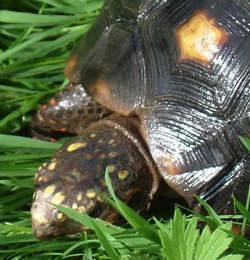Refrigeration Hibernation for Tortoises
Refrigeration hibernation is a method that has been used for many years amongst tortoise keepers.
There are both advantages and disadvantages using the refrigeration method.
Refrigeration hibernation can provide a constant temperature throughout the hibernation process whereas increasing variations in our weather make it difficult to maintain a constant temperature. Many hibernating species are waking up early in warm patches and then suffering in the inevitable frosts and cold patches before the end of the cold season. In the case of tortoises that have awoken early, they need to be kept indoors ideally and overwintered carefully. Use of artificial and natural (through windows) UV light is essential for diet stimulation. Access to a heatlamp is essential as always.
If you are going to use a fridge it is paramount that the temperature of the fridge can be controlled digitally to the desired temperature for hibernation. The use of a digital thermometer with a remote probe near the tortoise is wise secondary precaution, ideally with a maximum/minimum feature to monitor any fluctuation in the temperature.
Before you place a tortoise into the fridge it is important to ensure the temperature has stabilised over at least a week. A good way to achieve this is to fill the shelves with bottles full of water. Then, remove them from the top shelf to place the tray/tub with the tortoise inside. If more than one tortoise is being hibernated place them on the next shelf down etc. This way if the water bottles leak they are below the tortoise(s).
The fridge itself can be considered as a secure area for your tortoises. The tortoises will of course need to go into a ventilated plastic box once inside the fridge to keep them dry. You can hibernate more than one tortoise in the same fridge providing your fridge is big enough.
The disadvantages will be the cost of buying a fridge, the actual running costs of the fridge itself and the materials needed to maintain/monitor temperature etc. The fridge should be kept free from food and drinks or anything that could be a cause of mould; bacterial or fungal. Refrigerators can also take up valuable floor space. They should ideally be placed in a reasonably quiet, vibration free room that is typically above 10 degrees C.
Although technically, tortoises uses very little oxygen during hibernation, it is paramount that you provide air to the fridge at all times when hibernating the tortoise. This can be overcome by using a narrow piece of rigid tubing in the seal around the door allowing air to flow from the outside to inside the fridge. Taping can be used to seal any gaps created around the rigid tubing.
Before hibernating, please read our other blog on hibernating tortoises, for preparation tips and how to check on your hibernating tortoise.








